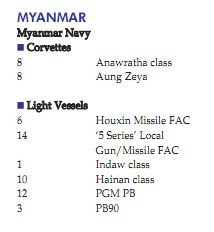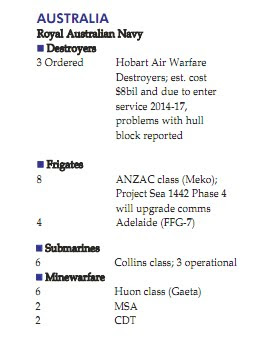27 Mei 2011
 Air Warfare Destroyer (photo : Australian DoD)
Air Warfare Destroyer (photo : Australian DoD)
The Minister for Defence Stephen Smith and the Minister for Defence Materiel Jason Clare today announced the reallocation of construction work for the $8 billion Air Warfare Destroyer (AWD) Project.
Australia is constructing three AWDs based on a proven design from the Spanish Navy. The ships are due to be delivered from December 2014. When complete, the AWD will be one of the more capable types of warship of its size in the world.
The AWD Project is an important element of Force 2030. The Government and Defence have been actively working with Defence Industry and the AWD Alliance, which is managing the AWD project, to deliver the project. The AWD Alliance consists of ASC, the Defence Materiel Organisation (DMO) and Raytheon.
Construction of the AWDs involves 90 separate steel blocks being built at three shipyards in Adelaide (ASC), Melbourne (BAE Systems) and Newcastle (Forgacs). Three additional sonar block assemblies are being built in Spain and the United Kingdom.
The Melbourne BAE Systems shipyard is also building 14 steel blocks for the superstructure of two new 27,500 tonne Landing Helicopter Dock ships (LHDs) due for delivery in 2014 and 2015.
Last year the project encountered difficulties in relation to engineering and construction of some of the first AWD hull blocks. To assist the AWD project schedule, earlier this year the AWD Alliance reallocated construction of nine steel blocks from BAE Systems in Melbourne to the Forgacs shipyard in Newcastle.
The Melbourne BAE Systems shipyard remains stretched, working on two major projects at the same time – steel blocks for the Air Warfare Destroyers and the superstructure and integration of the Landing Helicopter Dock Ships.
The Government, the AWD Alliance and BAE Systems take the schedule for both these important projects extremely seriously.
In February 2011, BAE Systems advised the AWD Alliance of potential schedule delays. Over the last few months, the AWD Alliance and BAE Systems have been working closely to develop options to improve the production program.
In March, the Minister for Defence met with Guy Griffiths, the Group Managing Director - International of BAE Systems UK, in London to discuss this project.
The Minister for Defence Materiel has also met with the CEO of BAE Australia, Jim McDowell, on a number of occasions about this project.
Earlier this month BAE Systems presented the AWD Alliance with a plan to adjust its workload on the AWD Project.
The advice of the AWD Alliance is that if no action is taken to relieve the pressure on the Melbourne BAE Systems shipyard the first ship would be two years late, approximately 25 per cent over schedule.
The AWD Alliance (with the support of BAE Systems) therefore proposes to take the following action:
Up to 13 steel blocks will be reallocated among the three Australian shipyards in Adelaide, Melbourneand Newcastle – seven for advanced fit out and six for construction; and
Up to five steel blocks will be reallocated to Navantia in Ferrol, Spain.
These changes involve the reallocation of blocks for the first two ships only and are subject in the usual way to satisfactory commercial arrangements with the shipyards.
BAE will complete the structural steel and initial outfitting work on the seven steel blocks it is currently working on, as well as all its work on the 14 blocks for the superstructure of the Landing Helicopter Dock Ships and the integration work.
A decision on the reallocation of blocks, if any, on the third AWD will be made later in the project.
This action will reduce the schedule risk to both this project and to the LHD ships project.
The AWD Alliance has advised that this action will reduce the delay of the completion of Ship 1 by up to 12 months, and of all three AWDs by up to 12 months.
It will also reduce the pressure on BAE Systems to complete the construction of the superstructure and the integration of Australia’s two new LHD ships.
Defence will plan its comprehensive options to manage the transition from the current Adelaide Class frigates to the AWDs taking into account the agreed reallocation of blocks.
(Australian DoD)
 KRI Nanggala 402 dalam pemeriksaan DSME (photo : Kaskus Militer)
KRI Nanggala 402 dalam pemeriksaan DSME (photo : Kaskus Militer)










































